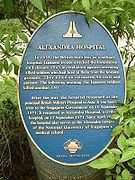 | ||
Similar Alexandra Hospital, Queen Alexandra's Military H, Johore Battery, Communicable Disease Centre, Johns Hopkins Singapor | ||
The British Military Hospital, Singapore was established in 1938 as the primary military hospital four miles west of Singapore at 378 Alexandra Road, and was also known as the Alexandra hospital for the area of Alexandra Park where it was built.
Contents
The Alexandra military hospital served as the principal hospital for the British Far East Command and was known as the British Military Hospital.
At the height of its existence, the hospital was an institution that adopted cutting-edge medical technology and was the first hospital in South East Asia to successfully perform limb re-attachment to a patient. The hospital was planned for years and on building included some of the best medical facilities in Asia, including the then new x-ray equipment.
Second World War
On 14 February 1942, Japanese Imperial Forces advanced through Kent Ridge down Pasir Panjang Road to the Alexandra Road Military Hospital. The British 1st Malaya Infantry Brigade retreated west through the Hospital. They set up machine guns on the first and second floors to cover their retreat. A lieutenant carried a Red Cross brassard and a white flag to meet the Japanese troops, and announce surrender of non-combatants in the hospital, but was killed immediately.
Among the patients in the Hospital were crew members who were survivors of Force Z, comprising the HMS Prince of Wales and HMS Repulse (nicknamed the Plymouth Argylls) which were sunk by Japanese torpedo bombers off the coast of Kuantan, Pahang, on 10 December 1941.
Japanese troops of the 18th Division rushed into the wards and operating theatres and bayoneted a total of 250 patients and staff members. Before they could repeat their brutalities in other wards, an officer ordered them to assemble in the Hospital grounds. The troops, however, removed about 400 patients and staff and locked them up in a small fetid room nearby, reminiscent of the Black Hole of Calcutta. Many died from suffocation. The next afternoon a cell door burst open under mortar fire and some men staggered out but many were mown down by Japanese machine-gun fire. Other survivors were taken out in small groups and shot. The bodies were buried in a mass grave. The Japanese claimed that some Indian troops had fired on them from the Hospital grounds. The area was a major Japanese objective because it also contained the British army's biggest ammunition dump and Alexandra Barracks.
Walter Salmon of the Royal Signals, wounded by a mortar bomb, was hospitalised on the top floor and had come to the canteen. He witnessed some of the massacre. Several men, including George Britton of the East Surrey Regiment, had been moved from the upstairs ward to the dining room and were in makeshift beds under the dining table. Corporal Britton later described how the Japanese rushed in, taking all the bread piled on the table. But although the orderly was marched out and bayoneted, those on the floor were ignored. They were left for 3 days with no food or water before being moved to Changi POW camp, on wheelbarrows, carts or anything that had wheels, no motorised vehicles being available.
In 2008 a four-page account of the massacre, written by Private Haines of the Wiltshire Regiment, was sold by private auction.
Other surviving staff and patients of the hospital were eventually transferred to the Roberts Barracks where their command was taken over by Colonel Glyn White of the Royal Australian Army Medical Corps.
Post-war period
After the Japanese Surrender in 1945, a book was kept in the Hospital. It contained the names of the victims who were massacred by the Japanese. The present location of the book is not known.
After World War II up to the 1970s, the Alexandra remained as one of the most modern hospitals in Singapore right to the 1970s, and is now a part of the National University of Singapore Medical School.
Notable staff
The Alexandra Hospital was also renowned for some of the well-known medical experts including:
